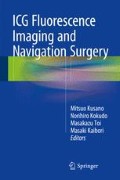Abstract
Pancreatic fistula (PF) remains the most serious complication of digestive surgery. The primary reason for PF not being successfully averted is that there are no techniques that identify pancreatic leak from the pancreatic stump during surgery or that rapidly evaluate protease activities in leakage fluid, which can cause severe tissue damage. To improve the safety of pancreatic surgery, the development of a novel technique that would identify pancreatic leak during surgery has been anticipated. We have designed and developed a novel fluorescence probe (glutaryl phenylalanine hydroxymethyl rhodamine green) that is activated by chymotrypsin in pancreatic juice. We evaluated the probe’s ability to identify a pancreatic leak and directly sprayed it on the pancreatic stump in an animal experiment; the real-time gross visualization of a pancreatic leak was confirmed.
Access this chapter
Tax calculation will be finalised at checkout
Purchases are for personal use only
Abbreviations
- PF:
-
pancreatic fistula
- ICG:
-
indocyanine green
- gPhe-HMRG:
-
glutaryl phenylalanine hydroxymethyl rhodamine green
References
Jemal A, Siegel R, Ward E et al (2008) Cancer statistics, 2008. CA Cancer J Clin 58:71–96
Yeo CJ, Cameron JL, Sohn TA et al (1997) Six hundred fifty consecutive pancreaticoduodenectomies in the 1990s: pathology, complications, and outcomes. Ann Surg 226:248–257
Mckay A, Mackenzie S, Sutherland FR et al (2006) Meta-analysis of pancreaticojejunostomy versus pancreaticogastrostomy reconstruction after pancreaticoduodenectomy. Br J Surg 93:929–936
Fuks D, Piessen G, Huet E et al (2009) Life-threatening postoperative pancreatic fistula (grade C) after pancreaticoduodenectomy: incidence, prognosis, and risk factors. Am J Surg 197:702–709
Kleeff J, Diener MK, Z'graggen K et al (2007) Distal pancreatectomy: risk factors for surgical failure in 302 consecutive cases. Ann Surg 245:573–582
Ishizawa T, Bandai Y, Ijichi M et al (2010) Fluorescent cholangiography illuminating the biliary tree during laparoscopic cholecystectomy. Br J Surg 97:1369–1377
Kaibori M, Ishizaki M, Matsui K et al (2011) Intraoperative indocyanine green fluorescent imaging for prevention of bile leakage after hepatic resection. Surgery 150:91–98
Sakaguchi T, Suzuki A, Unno N et al (2010) Bile leak test by indocyanine green fluorescence images after hepatectomy. Am J Surg 200:e19–e23
Whitcomb DC, Lowe ME (2007) Human pancreatic digestive enzymes. Dig Dis Sci 52:1–17
Yamashita S, Sakabe M, Ishizawa T et al (2013) Visualization of the leakage of pancreatic juice using a chymotrypsin-activated fluorescent probe. Br J Surg 100:1220–1228
Urano Y, Asanuma D, Hama Y et al (2009) Selective molecular imaging of viable cancer cells with pH-activatable fluorescence probes. Nat Med 15:104–109
Pompella A, De Tata V, Paolicchi A et al (2006) Expression of gamma-glutamyltransferase in cancer cells and its significance in drug resistance. Biochem Pharmacol 71:231–238
Veillette G, Dominguez I, Ferrone C et al (2008) Implications and management of pancreatic fistulas following pancreaticoduodenectomy: the Massachusetts General Hospital experience. Arch Surg 143:476–481
Balcom JH IV, Keck T, Warshaw AL et al (2002) Prevention of pancreatic fistula with a new synthetic, absorbable sealant: evaluation in a dog model. J Am Coll Surg 195:490–496
Bassi C, Dervenis C, Butturini G et al (2005) International Study Group on pancreatic fistula definition. Postoperative pancreatic fistula: an international study group (ISGPF) definition. Surgery 138:8–13
Gebauer F, Kloth K, Tachezy M et al (2012) Options and limitations in applying the fistula classification by the International Study Group for Pancreatic Fistula. Ann Surg 256:130–138
Shyr YM, Su CH, Wu CW et al (2003) Does drainage fluid amylase reflect pancreatic leakage after pancreaticoduodenectomy? World J Surg 27:606–610
Wormsley KG, Goldberg DM (1972) The interrelationships of the pancreatic enzymes. Gut 13:398–412
Dagorn JC, Sahel J, Sarles H (1977) Nonparallel secretion of enzymes in human duodenal juice and pure pancreatic juice collected by endoscopic retrograde catheterization of the papilla. Gastroenterology 73:42–45
Acknowledgment
This work was supported by grants from the Takeda Science Foundation; the Mochida Memorial Foundation for Medical and Pharmaceutical Research; the Ministry of Education, Culture, Sports, Science and Technology of Japan; and the Ministry of Health, Labour and Welfare of Japan.
Author information
Authors and Affiliations
Corresponding author
Editor information
Editors and Affiliations
Rights and permissions
Copyright information
© 2016 Springer Japan
About this chapter
Cite this chapter
Yamashita, S., Ishizawa, T., Kamiya, M., Urano, Y., Kokudo, N. (2016). Fluorescence Imaging for Intraoperative Identification of Pancreatic Leak. In: Kusano, M., Kokudo, N., Toi, M., Kaibori, M. (eds) ICG Fluorescence Imaging and Navigation Surgery. Springer, Tokyo. https://doi.org/10.1007/978-4-431-55528-5_34
Download citation
DOI: https://doi.org/10.1007/978-4-431-55528-5_34
Published:
Publisher Name: Springer, Tokyo
Print ISBN: 978-4-431-55527-8
Online ISBN: 978-4-431-55528-5
eBook Packages: MedicineMedicine (R0)

